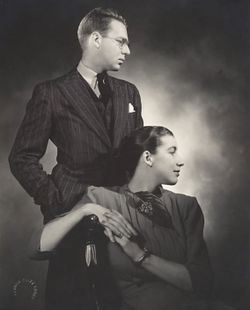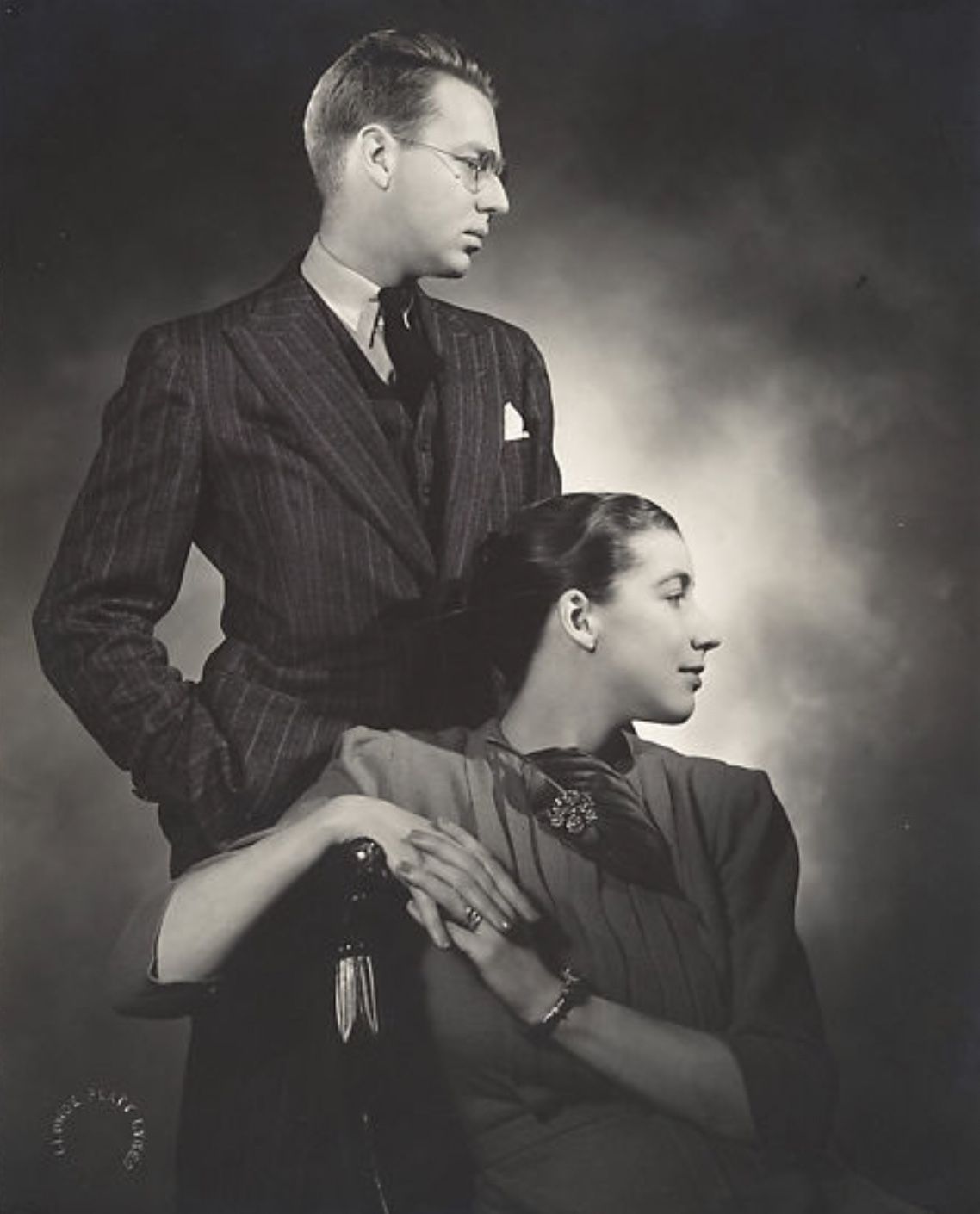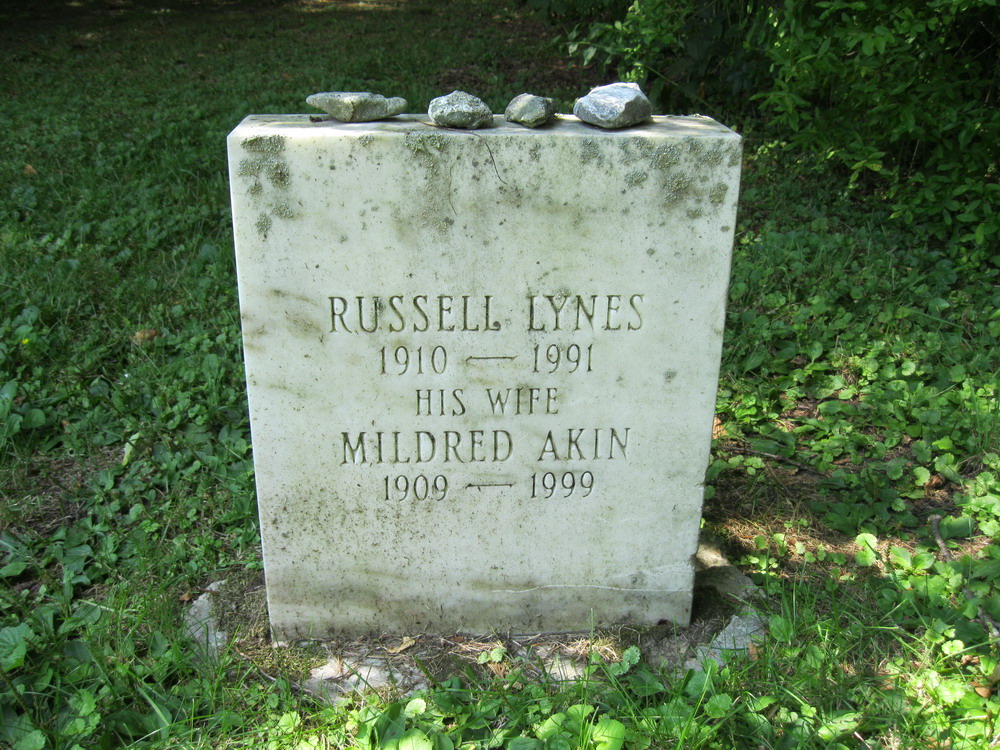WIFE: Mildred Akin
CHILDREN: George P. Lynes II / Elizabeth R. Lynes Hollander
Russell Lynes, a former managing editor of Harper's Magazine who for years was one of America's foremost arbiters of taste and mores, especially in architecture and the decorative arts, died Saturday night at Columbia-Presbyterian Medical Center in Manhattan. He was 80 years old and lived in Manhattan and North Egremont, Mass. He had been hospitalized several days for cardiac problems and his death was apparently caused by heart failure, said Michael Bessie, a friend. Essayist, social historian, photographer and Renaissance man, Mr. Lynes was an acclaimed expert on what was highbrow, what was lowbrow and what was no brow at all. One reviewer called him "the maestro of an unpretentious brand of social commentary which is civilized and stimulating." He was tweedy, bow-tied, pipe-smoking, buttoned-down and urbane, an aficionado of things like Bugatti cars and Downing cottages. He was also an indefatigible lamenter of a world that to him had become hopelessly wrapped in clear plastic.Watching People in Action Mr. Lynes was managing editor of Harper's from 1947 to 1967. Under him, it won renown for its thoughtful articles. But he was probably best known for books like "The Tastemakers" (1954), which contained wise and witty observations on American preferences, especially in architecture and decoration; "Snobs" (1950), a work that defined and examined types of American snobbery, and "Guests" (1951), which won praise for its analysis of boring people who could make a weekend seem like an eternity. "When you add up all the kinds of guests that Lynes throws rocks at, you get the feeling that maybe Lynes just doesn't like people," wrote Ted Robinson Jr. in The New York Times. But Mr. Lynes was always quick to point out that he did not dislike people; he only preferred to avoid certain types, even though he clearly enjoyed watching them in action. "I'm not a critic," he told Charlotte Curtis in a 1985 New York Times interview. "The public thinks of a critic as someone who's against everything, and I'm not. I'm amused by a lot of things." He tended to be most amused by stuffed shirts with more money than taste and unstuffed shirts who spent what little they had on vulgar design and overstated ornamentation. He was not the sort of person who appreciated plastic flamingos on suburban front lawns, but neither was he impressed by what he found on Park Avenue. "Why would anyone want to live on Park Avenue?" he once asked. "There's nothing to look at except the buildings across the way." For those who asked him what was in good taste and what was the opposite, he said he could not offer a definition. In any event, he clearly did not believe that people with good taste won fame and fortune. And he could prove it, he said, by listing those who made lots of money designing dreadful buildings. The quickest way to achieve fame, he said, was to "have an artificial heart put in you," even though "chances are you'll disappear quickly."From Education to Publishing Joseph Russell Lynes was born Dec. 2, 1910, in Great Barrington, Mass., a son of Joseph Russell Lynes and Adelaide Sparkman Lynes. His father was an Episcopal clergyman. Able to do just the right thing even at an early age, Mr. Lynes went to Yale, from which he graduated in 1932, and married Mildred Akin, a Vassar graduate, in 1934. He worked as a clerk at Harper & Brothers, the publishing house, from 1932 to 1936 and was director of publications at Vassar in 1936 and 1937. He then took a job at the Shipley School in Bryn Mawr, Pa., where he was assistant principal from 1937 to 1940, then principal until 1944. It was at that point that he joined Harper's Magazine as an assistant editor. There he flowered, and many books followed. Among them were "Highbrow, Lowbrow, Middlebrow" (1949), which poked fun at intellectual pretensions; "A Surfeit of Honey" (1957), a collection of essays, and "Cadwallader: A Diversion" (1959), a novel about a personable young rat. A collection of his photographs appeared in Mary Jean Kempner's "Invitation to Portugal" (1969). He also wrote many introductions to books on architecture and frequently contributed to magazines. An active writer to the end, Mr. Lynes saw his last book published by Cornelia and Michael Bessie Books this spring. It was titled "Life in the Slow Lane" and subtitled "Observations on Art, Architecture, Manners and Other Such Spectator Sports." Among his other activities was membership on the New York City Landmarks Preservation Commission (1962 to 1969), the trustees of the Collegiate School (1954 to 1962), and the trustees of the American Academy in Rome. Mr. Lynes also liked to play tennis, although he once conceded, "It is very hard to write while playing tennis or driving." In addition to his wife, Mr. Lynes is survived by a son, George P. Lynes 2d of New York City, a daughter, Elizabeth R. Lynes of Chicago, and three grandchildren.
WIFE: Mildred Akin
CHILDREN: George P. Lynes II / Elizabeth R. Lynes Hollander
Russell Lynes, a former managing editor of Harper's Magazine who for years was one of America's foremost arbiters of taste and mores, especially in architecture and the decorative arts, died Saturday night at Columbia-Presbyterian Medical Center in Manhattan. He was 80 years old and lived in Manhattan and North Egremont, Mass. He had been hospitalized several days for cardiac problems and his death was apparently caused by heart failure, said Michael Bessie, a friend. Essayist, social historian, photographer and Renaissance man, Mr. Lynes was an acclaimed expert on what was highbrow, what was lowbrow and what was no brow at all. One reviewer called him "the maestro of an unpretentious brand of social commentary which is civilized and stimulating." He was tweedy, bow-tied, pipe-smoking, buttoned-down and urbane, an aficionado of things like Bugatti cars and Downing cottages. He was also an indefatigible lamenter of a world that to him had become hopelessly wrapped in clear plastic.Watching People in Action Mr. Lynes was managing editor of Harper's from 1947 to 1967. Under him, it won renown for its thoughtful articles. But he was probably best known for books like "The Tastemakers" (1954), which contained wise and witty observations on American preferences, especially in architecture and decoration; "Snobs" (1950), a work that defined and examined types of American snobbery, and "Guests" (1951), which won praise for its analysis of boring people who could make a weekend seem like an eternity. "When you add up all the kinds of guests that Lynes throws rocks at, you get the feeling that maybe Lynes just doesn't like people," wrote Ted Robinson Jr. in The New York Times. But Mr. Lynes was always quick to point out that he did not dislike people; he only preferred to avoid certain types, even though he clearly enjoyed watching them in action. "I'm not a critic," he told Charlotte Curtis in a 1985 New York Times interview. "The public thinks of a critic as someone who's against everything, and I'm not. I'm amused by a lot of things." He tended to be most amused by stuffed shirts with more money than taste and unstuffed shirts who spent what little they had on vulgar design and overstated ornamentation. He was not the sort of person who appreciated plastic flamingos on suburban front lawns, but neither was he impressed by what he found on Park Avenue. "Why would anyone want to live on Park Avenue?" he once asked. "There's nothing to look at except the buildings across the way." For those who asked him what was in good taste and what was the opposite, he said he could not offer a definition. In any event, he clearly did not believe that people with good taste won fame and fortune. And he could prove it, he said, by listing those who made lots of money designing dreadful buildings. The quickest way to achieve fame, he said, was to "have an artificial heart put in you," even though "chances are you'll disappear quickly."From Education to Publishing Joseph Russell Lynes was born Dec. 2, 1910, in Great Barrington, Mass., a son of Joseph Russell Lynes and Adelaide Sparkman Lynes. His father was an Episcopal clergyman. Able to do just the right thing even at an early age, Mr. Lynes went to Yale, from which he graduated in 1932, and married Mildred Akin, a Vassar graduate, in 1934. He worked as a clerk at Harper & Brothers, the publishing house, from 1932 to 1936 and was director of publications at Vassar in 1936 and 1937. He then took a job at the Shipley School in Bryn Mawr, Pa., where he was assistant principal from 1937 to 1940, then principal until 1944. It was at that point that he joined Harper's Magazine as an assistant editor. There he flowered, and many books followed. Among them were "Highbrow, Lowbrow, Middlebrow" (1949), which poked fun at intellectual pretensions; "A Surfeit of Honey" (1957), a collection of essays, and "Cadwallader: A Diversion" (1959), a novel about a personable young rat. A collection of his photographs appeared in Mary Jean Kempner's "Invitation to Portugal" (1969). He also wrote many introductions to books on architecture and frequently contributed to magazines. An active writer to the end, Mr. Lynes saw his last book published by Cornelia and Michael Bessie Books this spring. It was titled "Life in the Slow Lane" and subtitled "Observations on Art, Architecture, Manners and Other Such Spectator Sports." Among his other activities was membership on the New York City Landmarks Preservation Commission (1962 to 1969), the trustees of the Collegiate School (1954 to 1962), and the trustees of the American Academy in Rome. Mr. Lynes also liked to play tennis, although he once conceded, "It is very hard to write while playing tennis or driving." In addition to his wife, Mr. Lynes is survived by a son, George P. Lynes 2d of New York City, a daughter, Elizabeth R. Lynes of Chicago, and three grandchildren.
Family Members
Sponsored by Ancestry
Advertisement
Records on Ancestry
Advertisement











